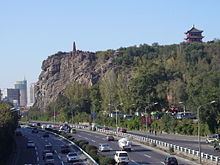 | ||
Similar Hongshan Park, People's Park, Bogda Peak, Heavenly Lake of Tianshan, Xinjiang Region Museum | ||
Hong Shan, Hongshan or the Red Mountain (Chinese: 红山; Pinyin: Hóng Shān; Uyghur: قىزىلتاغ, Қизилтағ; Qiziltagh) is an inner city mountain in Ürümqi, Xinjiang Uyghur Autonomous Region, China. The mountain, sometimes referred to as a hill for its smaller size than a mountain in land form, is the symbolic scenic spot of Ürümqi. The local Ürümqi Television Station adopted the shape of Hong Shan in red as its logo.
Contents
Map of Hongshan Mountain, Shuimogou, %C3%9Cr%C3%BCmqi, China, 830000
Etymology
As the rocks of the mountain reflect a bright red color, people call it Hong Shan ("Red Mountain" in Chinese). The red rocks are composed of dark purple sand gravel laid down during the Permian period. Hong Shan Mountain lies at the intersection of Hongshan Road (红山路) and Riverside Road (Hetan Road) (河滩路), Ürümqi, and is best viewed from Xi Daqiao Bridge.
History
Hong Shan Park is in the center of Ürümqi and contains a 1391-meter-high mountain. The temple lying on the hilltop is called Yu Huang Ge ("Chamber of Heavenly King") and is said to have been built during the Tang Dynasty (618-907 A.D.), when many monks studied scripture there. Since then, this chamber has become a place of tourism for business people from Central Asia and tourists from all over the world. Yu Huang Ge was famous and prosperous until a riot in 1930 destroyed this popular chamber.
There is a nine-storey pagoda named Zhen Long Ta at the top of the mountain. It was built in Yuan Dynasty (1277-1367 A.D.). This 25-meter pagoda has been preserved carefully ever since it was built. When the nightfall or sunset begins, the pagoda is marvelous; this view used to be one of the eight most famous scenic spots in ancient Ürümqi.
Before the Chinese government began the cultivation-planting project in Xinjiang, the mountain was bare and emerged without any trees. In the 1950s, therefore, after several years of cultivation planting, the mountain gained a brand-new look; the hill today is covered with trees, and the mountain looks beautiful.
